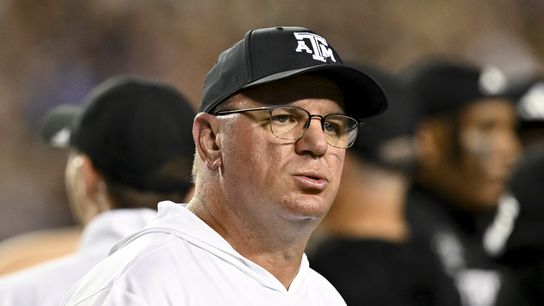Over the course of a football game, no play just happens. Every single snap has a winner and a loser.
Understanding this principle -- and, more importantly, getting his players to understand it -- has spurred Mike Elko to become one of the top third-down defensive coordinators in college football, and the Texas A&M defensive coordinator gave a third-down symposium at the Angelo Football Clinic last week.
In three seasons running A&M's defense, Elko's Aggies have placed second, fourth and first in getting off the field. Their 2020 third down percentage -- 34.96 -- was actually the highest of Elko's three seasons in Aggieland (30.25% in 2018, 31.58% in '19) but the median SEC offense converted over 40 percent of their third downs this past season. The Aggies permitted an even 25 percent (18 of 72) over their final seven games, a number that would have led the nation if spread over an entire season.
"You win or lose every single play in football," Elko told the assembled audience of mostly high school coaches. "Fundamental principles are far more important to your unit than any scheme that you run. Developing players with a high football IQ will also give you some built in advantages to how your defense can function together on the field."
Everything Elko teaches funnels to the larger point: players aren't asked to execute their assignment in a vacuum, but as a function of what the defense is trying to accomplish on that specific play.
To hammer this point home, Elko's third down philosophy begins on 1st-and-10.
1st and 10: The magic number here is three. "If the offense gets four or more, they keep their entire playbook open," Elko said. 1st and 10 is the down-and-distance closest to a true 50-50 run-pass split.
2nd and 7+: This is a half down -- the offense's goal is to get half the distance back. "If it's 2nd-and-10, you're defending like it's 3rd-and-5. This is not a down where you will see a lot of high risk plays," Elko said. RPOs, quick game, screen and draw are all likely options in this scenario.
2nd and 4-6: This down is treated like first down, the goal is to allow three yards or less. The offense likes to stick to their strengths here, Elko said, leaning on a low-risk play that keeps the ball moving forward.
2nd and 1-3: This is what Elko terms a "waste down." "This is where you have every shot play in the world coming at you," he said. To combat this, Elko likes to run zone pressure here -- something that closes the middle of the field to shot plays and gives him a chance to blitz.
Elko tasks a defensive manager to hold up a card with the down-and-distance before each play. He also tracks the Aggies' down-to-down win percentage across each practice, beginning with the first day of spring ball install.
"Third down is an eraser down for the offense and the defense," Elko said. "If you lose first and second down but win third, momentum goes up. If you win first and second but lose third, momentum goes down."
3rd and 11+: "We have to win 90 to 95 percent," Elko said. He calls his defenses anticipating max protection and deep route combinations -- lots of clear/dig, verts, and post corners.
"This is a flat out effort down for the defensive line," he said. "If I'm a D-lineman, they're blocking with seven and I've got to win with effort."
The coaching point for the coaches in the room is to communicate "double sticks" -- to make sure each player knows it's 3rd-and-11, not 3rd-and-1.
3rd and 8-10: Elko wants to win this down between 85 and 90 percent of the time, and he views it as a great opportunity to add extra rushers. With lots of high/low routes coming, Elko warns his players against covering the "idiot" routes. "They're the routes only an idiot would cover so the guy at the sticks gets open."
3rd and 4-6: These are the coin-flip plays that will determine whether the offense or defense wins third down over the course of a game. Surrender two of 12 and a defense did great, five of 12 and "you stunk."
Elko expects lots of man-to-man route concepts -- picks, mesh, bunch and stacks.
3rd and 2-3: This is a film study down, where a run or pass is dependent upon the opponent. Motion and shifts are common and you're defending personnel groupings more than anything else. "To get off the field, we need ball disruption up front. I'm rushing head up to knock the ball down," Elko said.
3rd and 1: This is a pure run down, and Elko deduced that with simple human psychology. "No OC wants their head coach screaming at them because they threw incomplete on 3rd-and-1."
Overall Philosophy
Elko wants to make the quarterback feel uncomfortable on third down, but this isn't simply accomplished via pass rush. Comfort, for the quarterback, starts pre-snap, and so Elko disguises both his blitzers and his coverages.
Crowding the line of scrimmage on third downs serves two purposes. Not only does it add a degree of difficulty for the quarterback to identify who's coming and who's not, it also turns the guys actually rushing into more effective blitzers. "It's very hard for a defensive player to hold their water. 'Stand at five yards, don't be early, don't be late.... Okay Coach, thanks.'"
That's not to say punishing the quarterback is unimportant, however. That's the final component to making the quarterback uncomfortable and, in turn, consistently getting off the field on third down. "If we hit him the first three third downs," Elko said, "those have been our best days."
